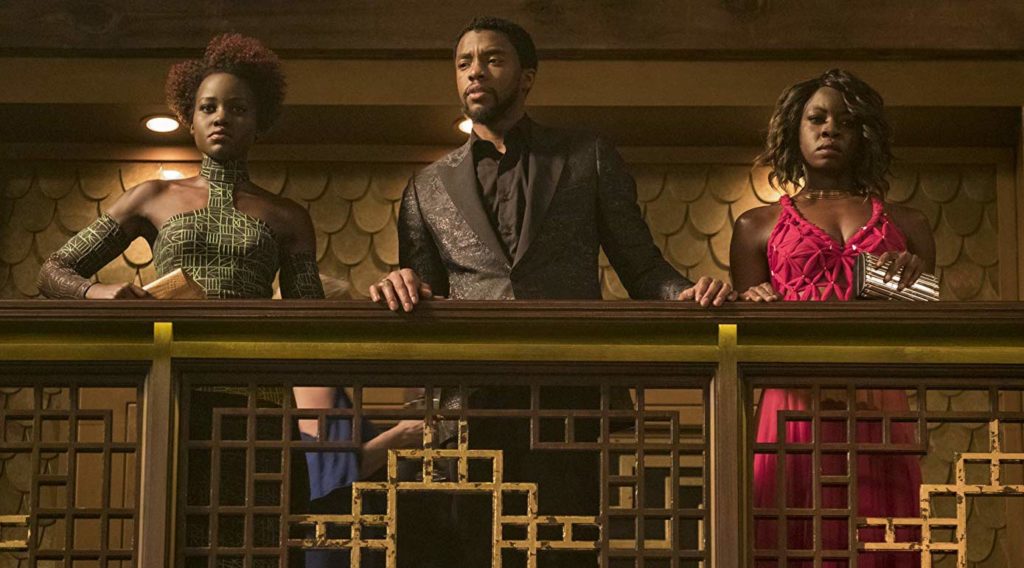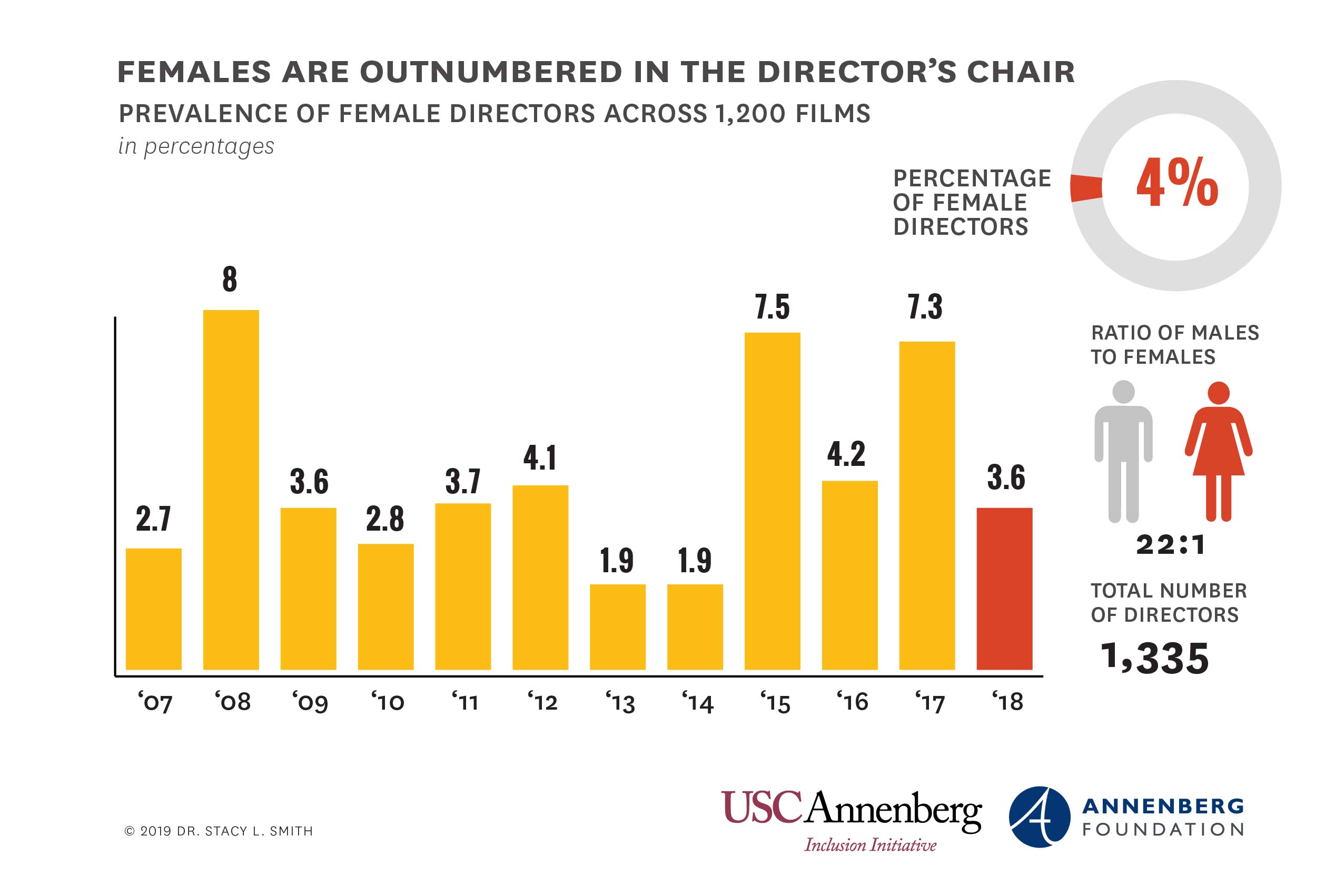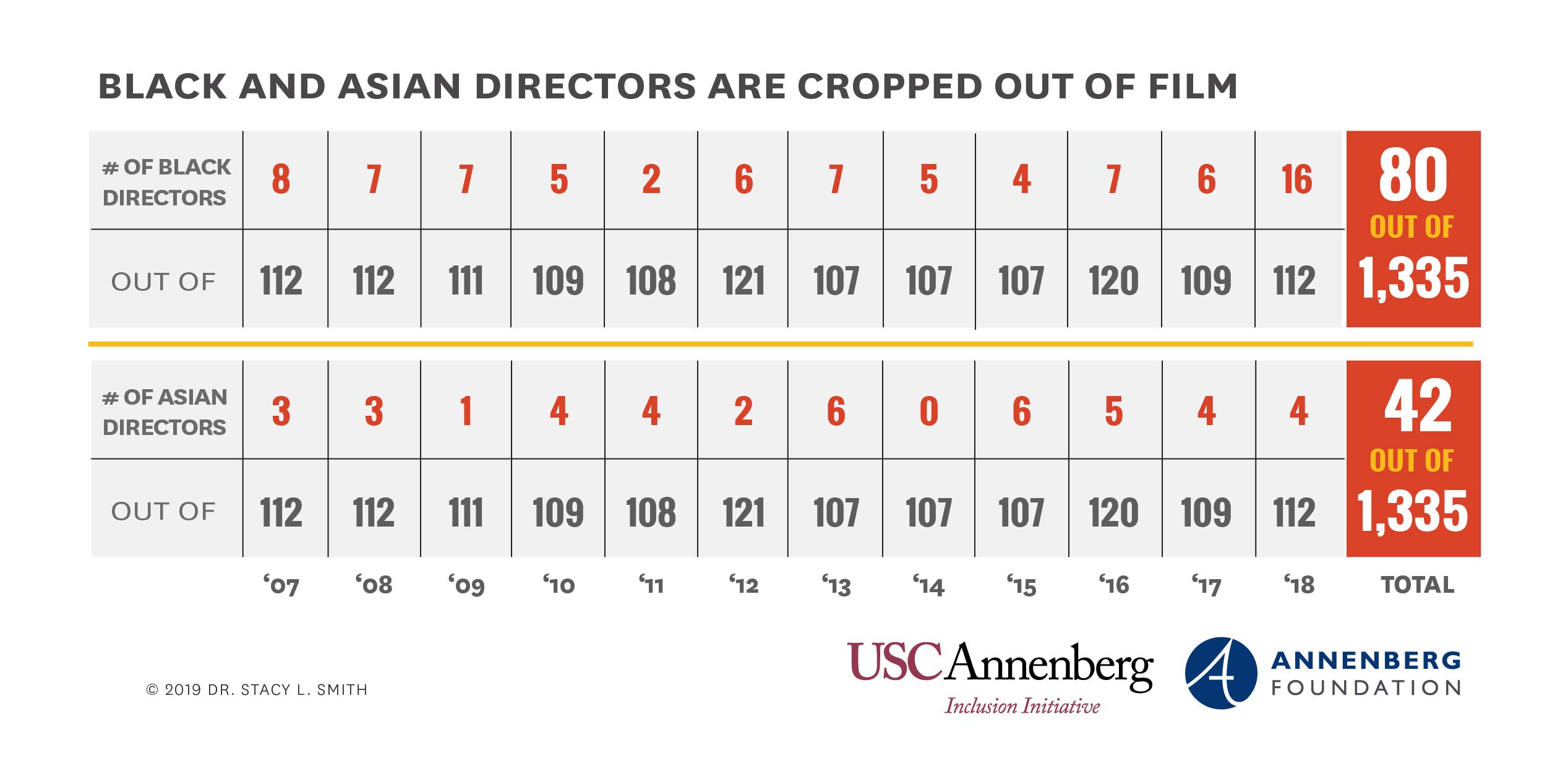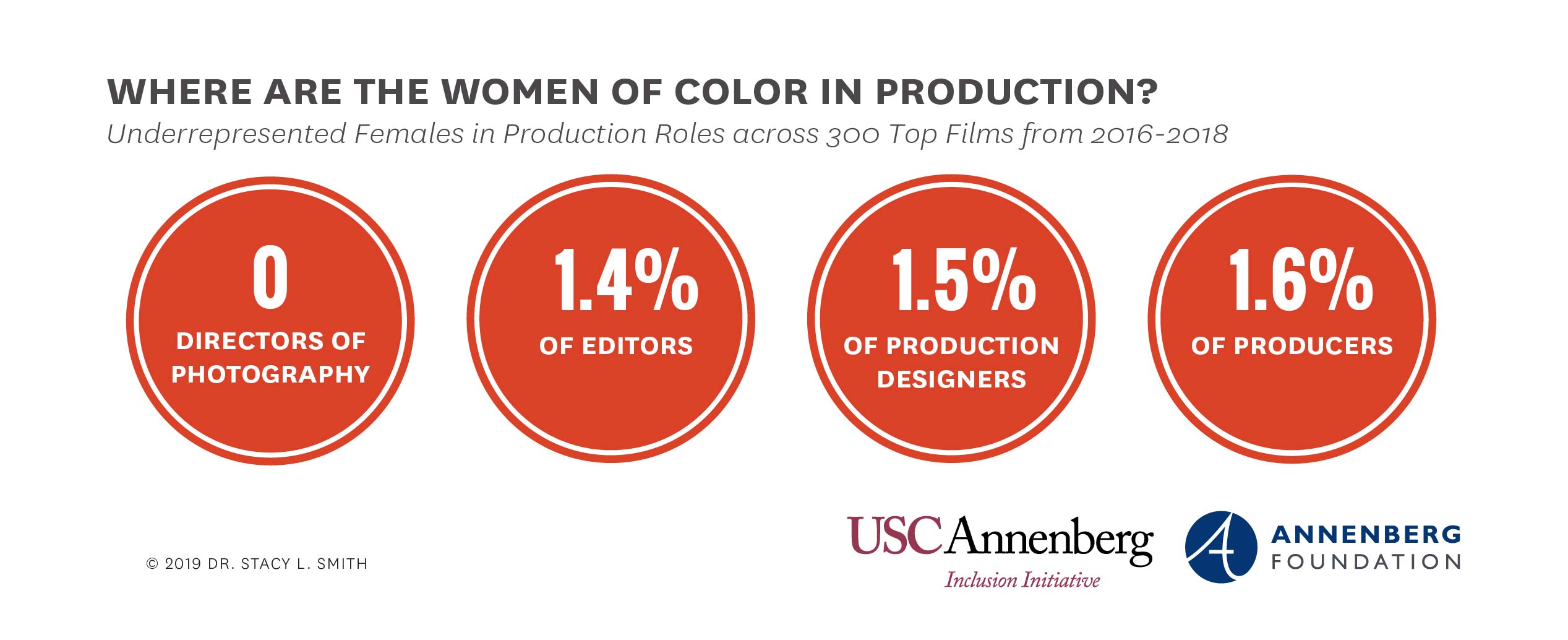The good news: The number of black directors working on top-grossing films reached a 12-year high in 2018. Sixteen black helmers, including “Black Panther’s” Ryan Coogler and “BlacKkKlansman’s” Spike Lee, were among the highest-grossing movies’ directors last year, almost tripling the figure from 2017 (six) and doubling 2007’s eight. The bad news: The needle for women directors has, once again, not moved. Only four women — Ava DuVernay, Kay Cannon, Abby Kohn, and Susanna Fogel — directed a top-earning film in 2018. That’s 3.6 percent, or a ratio of 27 male directors for ever woman director.
These are among the conclusions of the latest report from Dr. Stacy L. Smith and the USC Annenberg Inclusion Initiative, “Inclusion in the Director’s Chair: Gender, Race, & Age of Directors Across 1,200 Top Films from 2007 to 2018.” As Smith stated in a press release, the increase in black filmmakers is not only something to be celebrated, it shows that inclusion is possible, and profitable, when Hollywood gets its shit together. “While we do not see this [growth among black directors] mirrored among female or Asian directors, this offers proof that Hollywood can change when it wants to,” Smith said.
It definitely needs to change: the study’s cumulative, 12-year stats make that clear. From 2007-18, women represented just 4.3 percent of directors on the top 1,200 films. That’s 22 male directors for every woman helmer. Forty-six individual women directed top films from 2007-18. Thirty-nine were white, four black, two Asian, and one Latina. Overall, just six percent of helmers on 2007-18’s top films were black, and only 3.1 percent were Asian.
The study also examined production roles on the top films from 2016-18. Disappointingly, but as per usual, women of color are most often shut out of these positions. “Women of color are nearly invisible in film production — whether as directors, producers, or in below-the-line crew positions,” Smith remarked. “A mere 1.4 percent of editors, 1.5 percent of production designers, and 1.6 percent of producers were women of color. Only one woman of color worked as a composer across the 300 films we examined and there were no underrepresented female directors of photography.”
It’s great to see more black male directors among the top 2018 movies’ filmmakers. Audiences want new perspectives and stories at the cineplex, and in some ways, it seems Hollywood is finally recognizing that. Now it needs to get with the program and hire more women and women of color. In the coming years, it would be nice, say, if the number of WOC directors on the top 100 films also doubled or tripled. Here’s hoping.
Highlights from “Inclusion in the Director’s Chair” are below. You can read the full report here.
Film Directors
Gender
- A total of 112 directors helmed the 100 top-grossing films of 2018. 96.4% were men (n=108) and only 3.6% of directors were women (n=4), which calculates into a gender ratio of 27 to 1.
- The four women directors were Ava DuVernay (A Wrinkle in Time), Kay Cannon (Blockers), Abby Kohn (I Feel Pretty), and Susanna Fogel (The Spy Who Dumped Me).
- The percentage of female directors has not changed overtime. The 12-year high occurred in 2008, when 9 women directed across the annual sample of 100 movies.
- While the average age of directors did not vary by gender (Males=46.5 years, Females=46 years), career span did. Males work across 7 decades (20s-80s) whereas females work across 4 (30s-60s).
- 704 individual or unique directors helmed one of the 1,200 top-grossing films (658 men, 46 women). The range of work experience varied by gender, with men (1-17 films) having a larger directing span than women (1-4 films). The vast majority of female directors (83%) only made one film within the top-grossing sample in comparison to 54% of their male peers.
- Males were more likely to direct action films than were females, with a gender ratio of 68 to 1. Gender differences were also observed for science fiction films (34.7 males to 1 female) and thrillers (44 males to 1 female). Females were more likely than males to helm comedies (35.7% vs. 25.6%) and dramas (33.9% vs. 18%).
- Warner Bros. has distributed 12 films with female directors attached over the sample time frame. The distributor least female friendly is Paramount Pictures. There is no year between 2007 and 2018 in which every distributor has hired or attached at least one female director to a film. The most frequent number of female directors across 12 years of film slates is 0.
Race
- In 2018, 16 Black directors (14.3%) worked across the 100 top films of 2018. Of the Black helmers, 15 were male and only 1 was female. 2018 has the highest number and percentage of Black directors across the 12-year sample time frame. The number of Black helmers in 2018 is 2.7 times higher than the number in 2017 and twice as high as 2007.
- Of the 36 individual Black directors in the sample, over half (58.3%) have one directing credit across 1,200 films. 79 movies had one or more Black directors attached. Black helmers were most likely to direct dramas (36.7%, n=29), followed by comedies (32.9%, n=26) and action films (13.9%, n=11). A total of 4 horror (5.1%), 4 thriller (5.1%), 3 science fiction/fantasy movies (3.8%), and 2 animated films (2.5%) were directed by Black helmers.
- In terms of distributor, it is clear that the top performer in 2018 was Sony (5 films) followed by Universal Pictures (3 films). Both 20th Century Fox and Disney increased representation by attaching two Black directors to movies in their 2018 slates. Overtime, Lionsgate has distributed the most movies (n=20) with Black directors.
- A total of 4 Asian directors (3.6%) worked across the 100 top films of 2018. All four of these directors were men.
- Unlike their Black counterparts, there has been no change in the number or percentage of Asian directors over the 12-year sample time frame. Only 39 top directing jobs have been filled by Asian men and 3 by Asian women.
- Of the 41 movies helmed by an Asian director, 24.4% were animated, 19.5% were action oriented and 19.5% were horror. The remaining stories appeared in drama (12.2%), science fiction/fantasy (12.2%), comedy (7.3%), and thriller (4.9%). 71.4% (n=15) of Asian directors have current representation.
- In terms of distribution, 2018 was business as usual for Asian directors. Warner Bros increased representation of Asian directors in 2018 in comparison to 2017 and 2007. Universal Pictures has employed the highest number of Asian directors, presumably due to franchise successes such as The Fast and the Furious and Despicable Me. Lionsgate has only worked with 1 Asian director in 12 years across this sample.
- Overall, intersectionality is a large problem in the director’s chair. Women of color received very few opportunities across the 12-year time frame. Only 9 directing assignments have been filled by women of color across 1,200 top grossing pictures. These 9 jobs were held by seven women, 4 of which were Black, two Asian, and 1 Latina. Only 2 women of color have helmed 2 motion pictures in the sample time frame (Ava DuVernay, Jennifer Yuh Nelson).
Executives: C-suite, Corporate Board Seats, & Film Teams
- 17.3% of top executive positions (C-Suite) in major media companies were held by women, while 82.7% were held by males. Only 4 of these women were from underrepresented racial/ethnic groups.
- One-quarter of corporate Board seats were held by women across the 7 companies examined. This is a noticeable improvement over last year’s report, when only 18.8% of board seats were held by women. Despite overall gains, only 5 women of color were Corporate Directors.
- Only 2 of the Chairs of major executive film teams were female. The presence of women escalates as the analysis moves lower into the chain of command. 22.5% of President and Chief positions of executive film teams were held by women, while 36.4% of VP-level roles were filled by females. Across all these positions, only 8 women executives were from underrepresented racial/ethnic groups.
Film Producers
- A total of 984 individuals received the credit “Produced by” across 300 films from 2016-2018. Overall, 82.1% (n=808) of producers were male and 17.9% (n=176) were female. This calculates into a gender ratio of 4.6 male producers to every 1 female producer.
- Less than a sixth of all producers (11.4%) were from underrepresented racial/ethnic groups. This result deviated by year, with the percentage of underrepresented producers in 2017 (13.9%) higher than the percentage in 2016 (8.9%). Nearly three quarters (72.3%, n=710) of all producing jobs were held by white males. White females account for 16.3% (n=160) of all producers whereas underrepresented males account for 9.8% (n=96). Only 1.6% (n=16) of all producers were women of color.
- A total of 341 directors were responsible for the subset of 300 films, with 17.3% from underrepresented racial/ethnic groups. The percentage of underrepresented directors has increased significantly (9 percentage points) from 13.3% in 2016 to 22.3% in 2018. Only four women of color have directed across the 300 top films in comparison to 55 men of color, a ratio of 13.7 to 1. Films with an underrepresented producer on the team were more likely to have a diverse director attached (30.8%) than those films without an underrepresented producer (12%).
Below the Line
Camera
- A total of 266 individuals were credited as the director of photography (DP) across the top live action films from 2016-2018 (n=265). 97% were male (n=258) and 3% were female (n=8). This translates into 33 male lensers for every 1 female lenser. None of the female DPs were underrepresented and men of color only account for 15.8% (n=42) of cinematographers sample wide.
- 99.1% of A, B, or C camera operators were male (n=529) and <1% were female (n=5). Not one female A, B, or C camera operator worked across the top-grossing live action films of 2018. Of 281 gaffer jobs, not one was filled by a woman across three years of popular movies. Only a handful of employment opportunities went to women in the following categories: best boy electric (1 female, 292 males), key grip (4 females, 272 males), or best boy grip (8 females, 266 males).
Editors
- Credited editing jobs across the sample of films totaled to 375, with 84.5% (n=317) filled with males and 15.5% (n=58) filled with females. Roughly 5.5 males edited to every 1 female.
- 5.7% of editors were from underrepresented racial/ethnic groups, which did not vary by year: 2016 (5.7%), 2017 (4.1%), and 2018 (7.3%). Intersectionally, 79.9% (n=294) of editors were white men, 14.4% (n=53) were white women, 4.3% (n=16) were underrepresented men, and 1.4% (n=5) were underrepresented women. The ratio of white men editing to under-represented women was 58.8 to 1.
Composers
- 301 composers were credited across the top live action films from 2016-2018. 97.7% (n=294) of composers were male and 2.3% were female (n=7), which is a ratio of 42 to 1. The seven women each worked once across the 3-year sample.
- Few composers (9.6%, n=29) were from underrepresented racial/ethnic backgrounds. Twenty eight of the diverse composers were men and only 1 was a woman.
Art Department
- 273 individuals were credited as production designers, with 81.7% (n=223) male and 18.3% (n=50) female. Gender deviated by year, with female production designers less likely to work in 2018 (16.3%) than in 2017 (21.6%).
- Racial/ethnic diversity is also lacking at the top of this department. 94.1% (n=254) of production designers were white and only 5.9% (n=16) were people of color. Crossing gender and underrepresented status reveals an all too familiar picture: 77.4% (n=209) of production designers were white males, 16.7% (n=45) white females, 4.4% (n=12) were diverse males, and 1.5% (n=4) were diverse females.
Hair, Makeup, & Costume Design
- A full 78.5% of all hair department heads were women (n=219) and 21.5% were men (n=60). The gender ratio flips here, with 3.7 females working in this capacity to every 1 male. Women were more likely to work in this position in 2017 (83.5% and 2018 (81.9%) than in 2016 (70.2%). Over three quarters (76.4%, n=214) of make-up department heads were women and 23.6% (n=66) were men. Over time, an increase was observed with more women working in makeup in 2018 (81.3%) than in 2016 (72.8%) or 2017 (75%).
- Pivoting to costume designers, a total of 275 individuals were credited with this title. Only 15.6% of costume designers were male (n=43) and 84.4% were female (n=232). Gender differences emerged by year, with females less likely to work in 2017 (81.8%) than 2016 (87%). Only 14% of costume designers were from diverse racial/ethnic groups. Intersectionally, 73.2% of costume designers were white females, 12.9% were white males, 11% were diverse females, and 2.9% were diverse males.
Casting
- A total of 380 casting directors were credited across the sample. 83.4% of those positions were filled with women (n=317) and 16.6% were filled with men (n=63). For females, an increase was observed in the percentage of casting directors from 2017 (80.8%) to 2018 (86.1%).
- Only 13.2% of casting directors across the sample were underrepresented. Diverse casting directors worked significantly more in 2016 (14.6%) and 2018 (15.7%) than in 2017 (9%). Crossing gender and underrepresented status, white females (72%) were more likely to work as casting directors than white males (14.8%), women of color (11.8%) and men of color (1.3%). Differences also appeared by year, with losses in employment opportunities for white men in 2018 (10.2%) from 2017 (18.9%) and 2016 (15.5%).
Directorial Teams
- Four crew positions on the directorial team were examined for gender. Nearly a third of all Unit Production Manager (UPMs) were women (31.7%, n=115). Fewer women filled the first assistant director post (9%), again with no year to year change. Roughly a third of all second assistant directors (33.6%) and second seconds (31.9%) were women. Of these two jobs titles, a notable increase was observed for female second assistant directors from 2016 (29.4%) to 2018 (37.6%).










